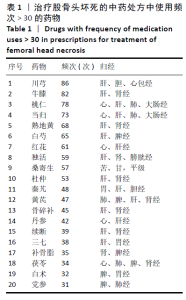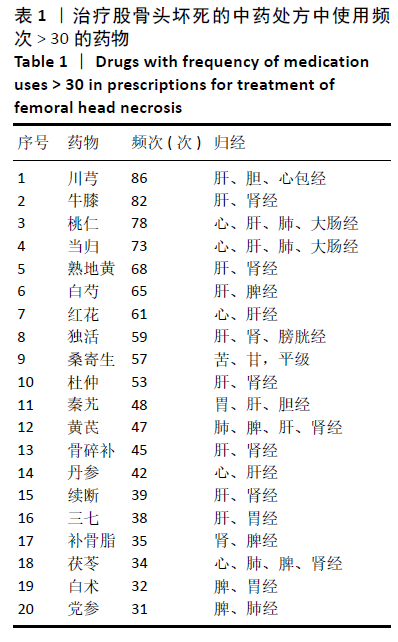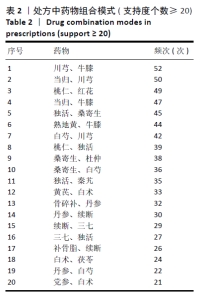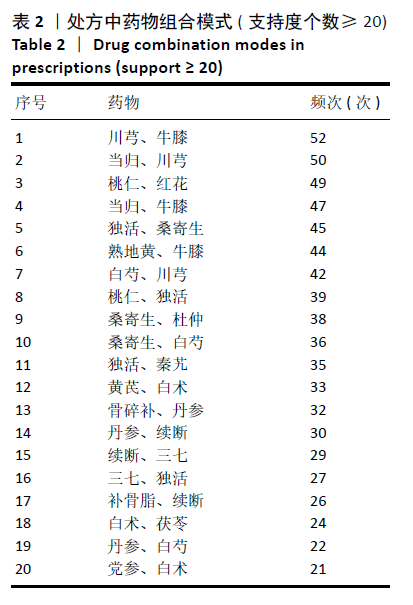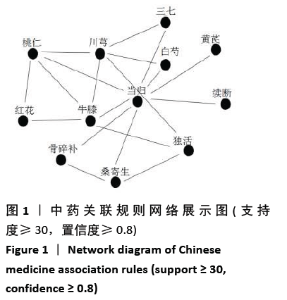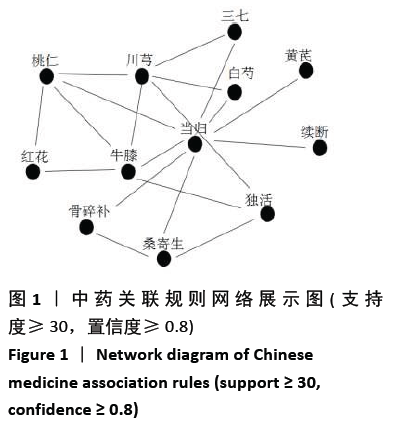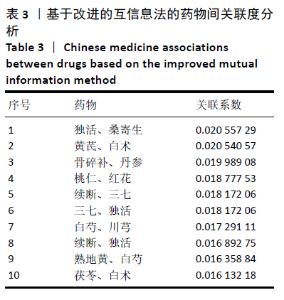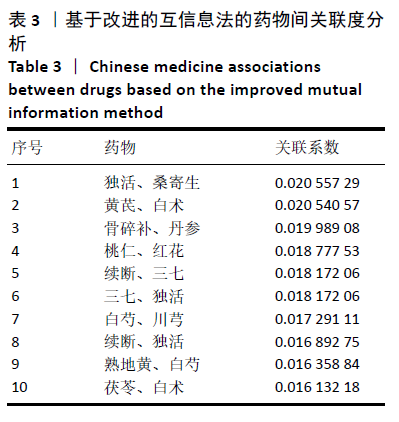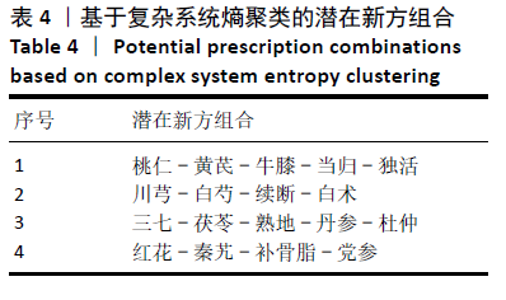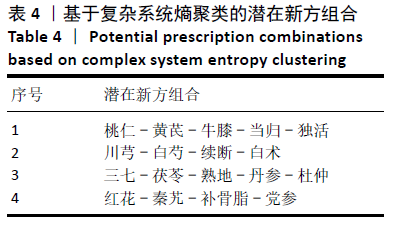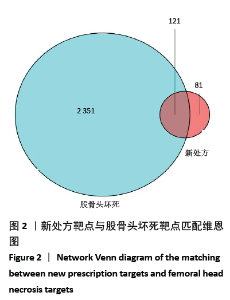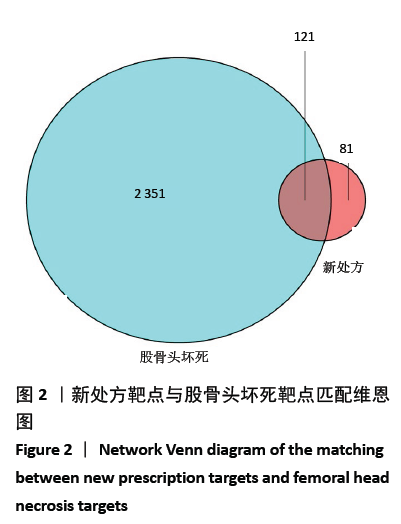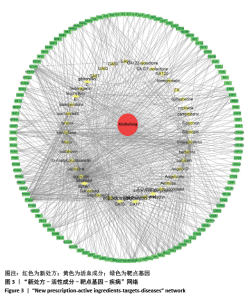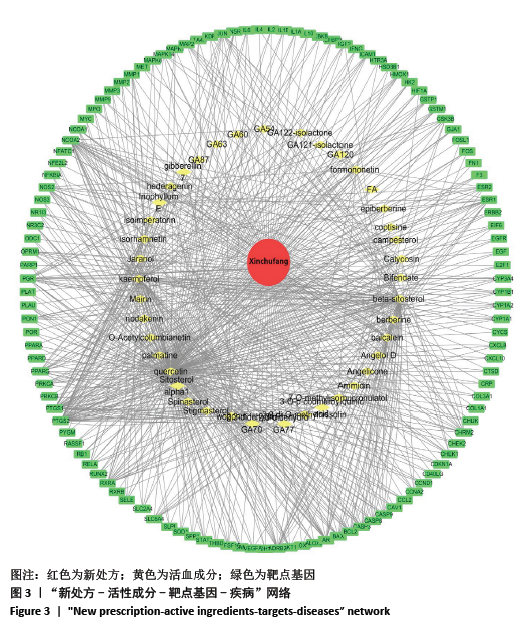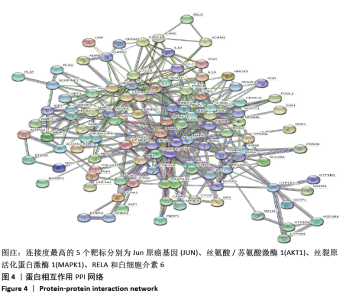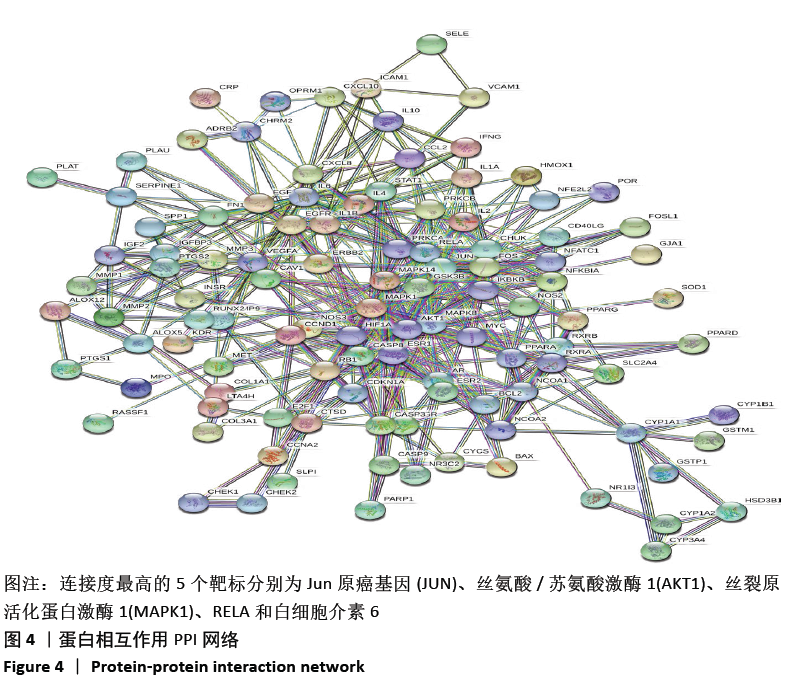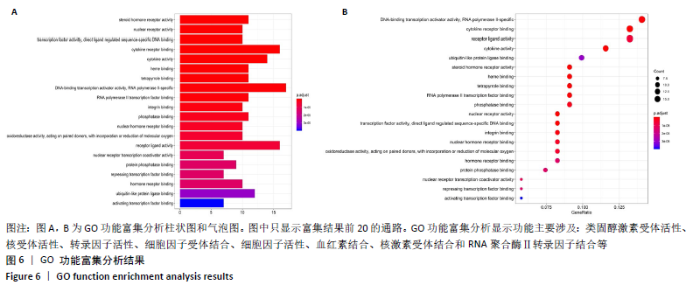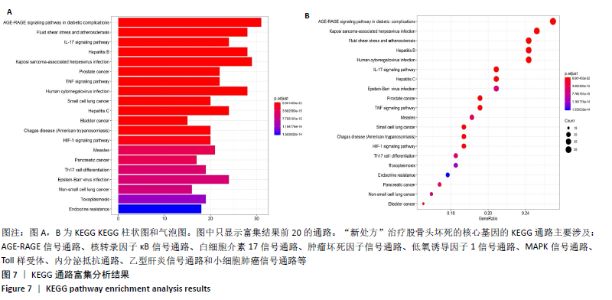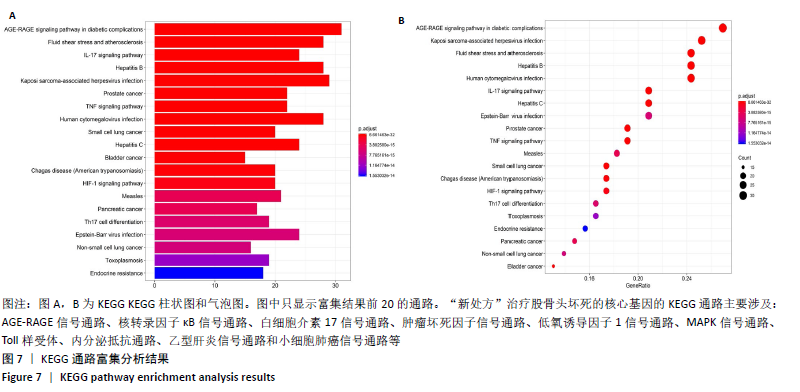Chinese Journal of Tissue Engineering Research ›› 2021, Vol. 25 ›› Issue (32): 5148-5154.doi: 10.12307/2021.217
Previous Articles Next Articles
Medication rules and mechanism of femoral head necrosis: an analysis based on data mining and network pharmacology
Wang Ding1, Lin Tianye2, Chen Weijian3, Chen Jianfeng1, Ou Huizhi1, Li Hongzhu4, Yang Peng2, Wei Qiushi5, He Wei5, Feng Zongquan1
-
Received:2020-08-05Revised:2020-08-11Accepted:2020-09-11Online:2021-11-18Published:2021-07-26 -
Contact:Feng Zongquan, Chief physician, Foshan Traditional Chinese Medicine Hospital, Foshan 528000, Guangdong Province, China -
About author:Wang Ding, MD, Attending physician, Foshan Traditional Chinese Medicine Hospital, Foshan 528000, Guangdong Province, China -
Supported by:the National Natural Science Foundation of China, No. 81873327 (to HW); Scientific Research Project of Traditional Chinese Medicine Bureau of Guangdong Province, No. 21091116 (to YP)
CLC Number:
Cite this article
Wang Ding, Lin Tianye, Chen Weijian, Chen Jianfeng, Ou Huizhi, Li Hongzhu, Yang Peng, Wei Qiushi, He Wei, Feng Zongquan. Medication rules and mechanism of femoral head necrosis: an analysis based on data mining and network pharmacology[J]. Chinese Journal of Tissue Engineering Research, 2021, 25(32): 5148-5154.
share this article
Add to citation manager EndNote|Reference Manager|ProCite|BibTeX|RefWorks
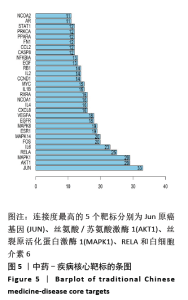
蛋白靶点用节点表示,靶点间作用关系用边表示,共包含节点121个,边452条,连接度值平均为7.47。经“Network Analyzer”工具计算得出各作用靶标的连接度,见图5,图中连接度最高的5个靶标分别为Jun原癌基因(Jun proto-oncogene,AP-1 transcription factor subunit,JUN)、丝氨酸/苏氨酸激酶1(serine/threonine kinase 1,AKT1)、丝裂原活化蛋白激酶1(Mitogen-activated protein kinase 1,MAPK1)、RELA和白细胞介素6。因此,文章认为上述5 个靶标在新处方治疗股骨头坏死中发挥了重要作用,为潜在核心靶标。结合图3亦可看出,上述5 个作用靶标可影响多个靶标,进一步证实了“新处方”治疗股骨头坏死不仅是通过作用于多个靶标而发挥多种效果,还通过靶标之间的相互作用产生了复杂的网络调节效果。 "
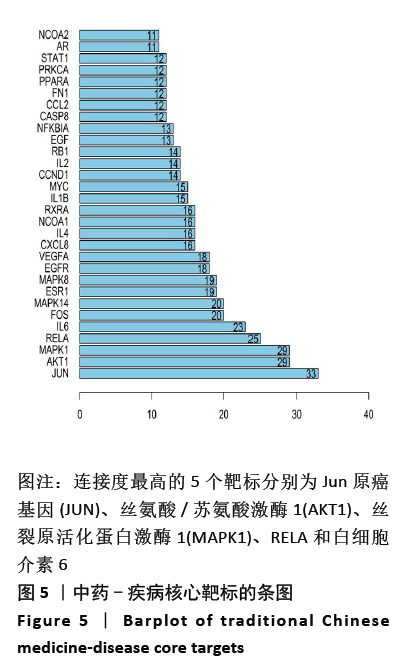
| [1] MONT MA, CHERIAN JJ, SIERRA RJ, et al. Nontraumatic osteonecrosis of the femoral head: where dowe stand today? A ten-year update. J Bone Joint Surg Am. 2015;97:1604-1627. [2] SHIBATANI M, FUJIOKA M, ARAI Y, et al. Degree of corticosteroid treatment within the first 2 months of renal transplan-tation has a strong influence on the incidence of osteonecrosis of the femoral head. Acta Orthop. 2008;79(5):631-636. [3] SHIGEMURA T, NAKAMURA J, KISHIDA S, et al. Incidence of osteonecrosis associated with corticosteroid therapy among different underlying diseases: prospective MRI study. Rheumatology (Oxford). 2011;50(11): 2023-2028. [4] SADILE F, BERNASCONI A, CARBONE F, et al. Histological fibrosis may predict the failure of core decompression in the treatment of osteonecrosis of the femoral head. Int J Surg. 2017;44:303-308. [5] FUKUSHIMA W, FUJIOKA M, KUBO T, et al. Nationwide epidemiologic survey of idiopathic osteonecrosis of the femoral head. Clin Orthop Relat Res. 2010;468(10):2715-2724. [6] Koo KH, Song HR, Yang JW, et al. Trochanteric rotational osteotomy for osteonecrosis of the femoral head. J Bone Joint Surg Br. 2001;83(13):83-89. [7] BESSETTE BJ, FASSIER F, TANZER M,et al. Total hip arthroplasty in patients younger than 21 years: a minimum, 10-year follow-up. Can J Surg. 2003;46(5):257-262. [8] 苏诗瑶,姚啸生,于冬冬,等.辨证论治应用中医药防治股骨头坏死的研究进展[J].实用中医内科杂志,2020,34(6):17-20. [9] 陈海诚,袁颖嘉,黄楚瑶,等.股骨头坏死外科脱位入路打压植骨支撑术后超早期康复介入的保髋效果[J].中国组织工程研究,2019,23(24):3812-3818. [10] 魏秋实,张颖,曾平,等.活血通络法对静息性股骨头坏死的临床和影像表现的干预作用[J].时珍国医国药,2018,29(4): 890-893. [11] 赵德伟,胡永成.成人股骨头坏死诊疗标准专家共识(2012年版)[J].中华关节外科杂志(电子版),2012,6(3):479-484. [12] MONT MA, MARULANDA GA, JONES LC, et al. Systematic analysis of classification systems for osteonecrosis of the femoral head. J Bone Joint Surg Am. 2006;88 Suppl 3: 16-26. [13] XU X, ZHANG W, HUANG C, et al. A novel chemometric method for the prediction of human oral bioavailability. Int J Mol Sci. 2012;13(6):6964-6982. [14] WALTERS WP, MURCKO MA. Prediction of ‘drug-likeness’. Adv Drug Deliv Rev. 2002; 54(3):255-271. [15] LIU J, PEI T, MU J, et al. Systems Pharmacology Uncovers the Multiple Mechanisms of Xijiao Dihuang Decoction for the Treatment of Viral Hemorrhagic Fever. Evid Based Complement Alternat Med. 2016;2016:9025036. [16] 于潼,谢利民.股骨头坏死的中医病因病机及辨证分型的探讨[J].北京中医药, 2010,29(5):393-396. [17] 于潼,谢利民,王文岳,等.从中医证候学研究探讨股骨头坏死的病因病机[J].中国中医骨伤科杂志,2014,22(3):74-76. [18] 郑升鹏,曾志奎,姜自伟,等.基于数据挖掘的骨质疏松症用药规律研究[J].中华中医药学刊,2018,36(2):341-344. [19] 邓树泳,李静,罗来成.中药药对的现代研究进展[J].时珍国医国药,2012,23(4): 1003-1005. [20] 唐仕欢,杨洪军.中医组方用药规律研究进展述评[J].中国实验方剂学杂志,2013, 19(5):359-363. [21] 孔维霞,朱恒,江小霞,等.MAPK通路参与小鼠骨实质来源间充质干细胞向成骨的分化[J].中国实验血液学杂志,2010, 18(4):981-985. [22] 王钰钢,范启明,汤亭亭,等.AMPK信号通路对骨代谢的调节作用[J].中国骨质疏松杂志,2014,20(3):322-326. [23] PISANI LP, ESTADELLA D, RIBEIRO DAI, et al. The Role Of Toll Like Rectors (TLLRs) in Oral Carcinogenesis. Anticer Resz. 2017; 37(10):5389-539. [24] OKAYAKI S, NAGOYA S, MATSUMOTO H, et al. TLR4 Stimulation and corticosteroid intricately induce osteonecroisis of the femoral head in rat. J Orthop Res. 2016; 34(2):342-345. [25] HUTAMI IR, TANAKA E, IYAWA T, et al. Crosstalk Bass Fas and S1P1 Signing Via Via NK-κB in Osteoclasts Bonds Bone Destruction in thy TMJ Due to Rheumatoid Arthritis. Jpn Den Sci Rev. 2019;55(1):12-19. [26] OKAYAKI S, NAGOYA S, MATSUMOTO H, et al. TLR4 Stimulation and Corticosteroid Interactively Induce Osteonecrois of the Femoral Head In Rat. J Orthop Res. 2016; 34(2):342-345. [27] SCHEREIBER T, SALHOFER L, KUNING T, et al. Thanks get brozken: thee hypoxia induclibly facility prolyl hydroxaes in ischemic heat disaase. Basic Res Card. 2019;114(3):16. [28] LI J, FAN L, KU Y, et al. The ffect of the deferoxamine on angionesis and bon bon repairer in steroid induce osteonecrosis of rabbit health federal beards. Exp Biol Med. 2015;240(2):273-280. [29] ZHANG W, GUAN Z, PEI X, et al. In vivo and in inviting characteristic of off hif-1alph and end relative génés insignificance. Int J Clin Exp Patol. 2015;8(6):7210-7216. [30] 徐炜. HIF-1α/SDF-1/CXCR4信号轴在颅脑损伤时骨折加速愈合中的作用及实验研究[D].苏州:苏州大学,2019. |
| [1] | Wu Taoguang, Nie Shaobo, Chen Hua, Zhu Zhengguo, Qi Lin, Tang Peifu. Biomechanical characteristics of a new multi-dimensional cross locking plate in the treatment of subtrochanteric nonunion [J]. Chinese Journal of Tissue Engineering Research, 2023, 27(9): 1330-1334. |
| [2] | Wu Tianliang, Tao Xiuxia, Xu Hongguang. Influence of different bone mineral densities on cage subsidence after stand-alone oblique lateral interbody fusion: three-dimensional finite element analysis [J]. Chinese Journal of Tissue Engineering Research, 2023, 27(9): 1352-1358. |
| [3] | Wen Xinghua, Ding Huanwen, Cheng Kai, Yan Xiaonan, Peng Yuanhao, Wang Yuning, Liu Kang, Zhang Huiwu. Three-dimensional finite element model analysis of intramedullary nailing fixation design for large femoral defects in Beagle dogs [J]. Chinese Journal of Tissue Engineering Research, 2023, 27(9): 1371-1376. |
| [4] | Ke Yuqi, Chen Changjian, Wu Hao, Zheng Lianjie. Comparison of 12-month follow-up results of primary total hip arthroplasty between modified direct anterior approach and direct anterior approach [J]. Chinese Journal of Tissue Engineering Research, 2023, 27(9): 1377-1382. |
| [5] | Zheng Hongrui, Zhang Wenjie, Wang Yunhua, He Bin, Shen Yajun, Fan Lei. Femoral neck system combined with platelet-rich plasma in the treatment of femoral neck fracture [J]. Chinese Journal of Tissue Engineering Research, 2023, 27(9): 1390-1395. |
| [6] | Pan Zhongjie, Qin Zhihong, Zheng Tiejun, Ding Xiaofei, Liao Shijie. Targeting of non-coding RNAs in the pathogenesis of the osteonecrosis of the femoral head [J]. Chinese Journal of Tissue Engineering Research, 2023, 27(9): 1441-1447. |
| [7] | He Yinhao, Li Xiaosheng, Chen Hongwen, Chen Tiezhu. 3D printed porous tantalum metal in the treatment of developmental dysplasia of the hip: current status and application prospect [J]. Chinese Journal of Tissue Engineering Research, 2023, 27(9): 1455-1461. |
| [8] | Dang Yi, Du Chengyan, Yao Honglin, Yuan Nenghua, Cao Jin, Xiong Shan, Zhang Dingmei, Wang Xin. Hormonal osteonecrosis and oxidative stress [J]. Chinese Journal of Tissue Engineering Research, 2023, 27(9): 1469-1476. |
| [9] | Zhong Yizheng, Huang Peizhen, Cai Qunbin, Zheng Liqin, He Xingpeng, Dong Hang. Microstructural indexes that determine the trabecular bone maximum stress of micro-finite element models [J]. Chinese Journal of Tissue Engineering Research, 2023, 27(9): 1313-1318. |
| [10] | Sun Jiajia, Zhu Haidi, Lu Yun, Zhang Kai. Comparison of bone metabolism markers between type 2 diabetes mellitus and non-type 2 diabetes mellitus patients with hip fracture [J]. Chinese Journal of Tissue Engineering Research, 2023, 27(8): 1156-1160. |
| [11] | Huang Linke, Wei Linhua, Jiang Jie, Liu Qian, Chen Weiwei. Effects of estrogen combined with treadmill exercise on bone mass and articular cartilage in ovariectomized mice [J]. Chinese Journal of Tissue Engineering Research, 2023, 27(8): 1166-1171. |
| [12] | Yang Zhishan, Tang Zhenglong. YAP/TAZ, a core factor of the Hippo signaling pathway, is involved in bone formation [J]. Chinese Journal of Tissue Engineering Research, 2023, 27(8): 1264-1271. |
| [13] | Bai Yulong, Li Zhonghai, Zhao Yantao, Xia Cencan, Shi Lei. History, current situation and prospect of tissue banks in China [J]. Chinese Journal of Tissue Engineering Research, 2023, 27(8): 1306-1312. |
| [14] | Liu Jiaxin, Jia Peng, Men Yutao, Liu Lu, Wang Yeming, Ye Jinduo. Design and optimization of bone trabecular structure with triply periodic minimal surfaces [J]. Chinese Journal of Tissue Engineering Research, 2023, 27(7): 992-997. |
| [15] | Yuan Hucheng, Ding Yongguo, Ma Xuehua, Ma Wenxin, Sun Jianmin, Wang Zili, Jin Weidong. Sustained releasing of pyrazinamide, capreomycin, moxifloxacin and amikacin loaded bone cement in vitro [J]. Chinese Journal of Tissue Engineering Research, 2023, 27(7): 1017-1022. |
| Viewed | ||||||
|
Full text |
|
|||||
|
Abstract |
|
|||||
